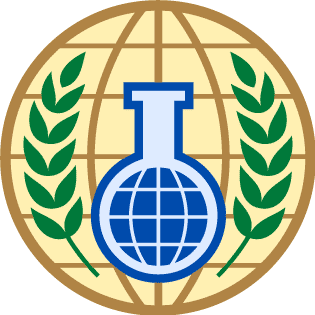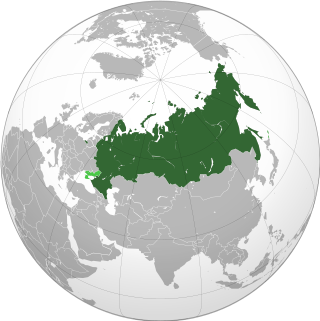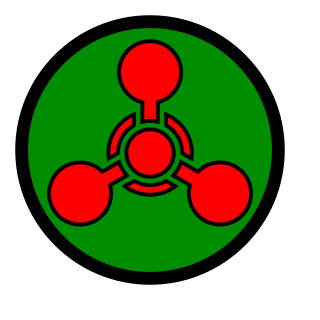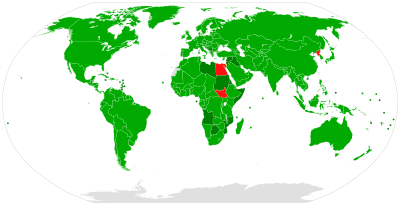
The Organisation for the Prohibition of Chemical Weapons (OPCW) is an intergovernmental organisation and the implementing body for the Chemical Weapons Convention (CWC), which entered into force on 29 April 1997. The OPCW, with its 193 member states, has its seat in The Hague, Netherlands; it oversees the global endeavour for the permanent and verifiable elimination of chemical weapons.

Chemical warfare (CW) involves using the toxic properties of chemical substances as weapons. This type of warfare is distinct from nuclear warfare, biological warfare and radiological warfare, which together make up CBRN, the military acronym for chemical, biological, radiological, and nuclear, all of which are considered "weapons of mass destruction" (WMDs), a term that contrasts with conventional weapons.

Sarin is an extremely toxic organophosphorus compound. A colourless, odourless liquid, it is used as a chemical weapon due to its extreme potency as a nerve agent. Exposure can be lethal even at very low concentrations, where death can occur within one to ten minutes after direct inhalation of a lethal dose, due to suffocation from respiratory paralysis, unless antidotes are quickly administered. People who absorb a non-lethal dose and do not receive immediate medical treatment may suffer permanent neurological damage.

The Russian Federation is known to possess or have possessed three types of weapons of mass destruction: nuclear weapons, biological weapons, and chemical weapons. It is one of the five nuclear-weapon states recognized under the Treaty on the Non-Proliferation of Nuclear Weapons.

José Maurício de Figueiredo Bustani is a Brazilian diplomat who was the first director-general of the Organisation for the Prohibition of Chemical Weapons until he was ousted after pressure from the US government in April 2002 over disagreements about how to address Iraq's alleged weapons of mass destruction.

Many nations continue to research and/or stockpile chemical weapon agents despite numerous efforts to reduce or eliminate them. Most states have joined the Chemical Weapons Convention (CWC), which required the destruction of all chemical weapons by 2012. Twelve nations have declared chemical weapons production facilities and six nations have declared stockpiles of chemical weapons. All of the declared production facilities have been destroyed or converted for civilian use after the treaty went into force.
Methylphosphonyl difluoride (DF), also known as EA-1251 or difluoro, is a chemical weapon precursor. Its chemical formula is CH3POF2. It is a Schedule 1 substance under the Chemical Weapons Convention. It is used for production of sarin and soman as a component of binary chemical weapons; an example is the M687 artillery shell, where it is used together with a mixture of isopropyl alcohol and isopropyl amine, producing sarin.

Albania once possessed a stockpile of weapons of mass destruction. This stockpile of chemical weapons included 16,678 kilograms (36,769 lb) of mustard gas, lewisite, adamsite, and phenacyl chloride (chloroacetophenone).

Libya pursued programs to develop or acquire weapons of mass destruction from when Muammar Gaddafi seized control of Libya in 1969 until he announced on 19 December 2003 that Libya would voluntarily eliminate all materials, equipment and programs that could lead to internationally proscribed weapons. This included weapons of mass destruction and long-range ballistic missiles.

Syria and weapons of mass destruction deals with the research, manufacture, stockpiling and alleged use by Syria of weapons of mass destruction, which include chemical and nuclear weapons.

A chemical weapon (CW) is a specialized munition that uses chemicals formulated to inflict death or harm on humans. According to the Organisation for the Prohibition of Chemical Weapons (OPCW), this can be any chemical compound intended as a weapon "or its precursor that can cause death, injury, temporary incapacitation or sensory irritation through its chemical action. Munitions or other delivery devices designed to deliver chemical weapons, whether filled or unfilled, are also considered weapons themselves."
The United States chemical weapons program began in 1917 during World War I with the creation of the U.S. Army's Gas Service Section and ended 73 years later in 1990 with the country's practical adoption of the Chemical Weapons Convention. Destruction of stockpiled chemical weapons began in 1986 and was completed on July 7, 2023. The U.S. Army Medical Research Institute of Chemical Defense (USAMRICD), at Aberdeen Proving Ground, Maryland, continues to operate.
Syria's chemical weapons program began in the 1970s with weapons and training from Egypt and the Soviet Union, with production of chemical weapons in Syria beginning in the mid-1980s. For some time, Syria was believed to have the world's third-largest stockpile of chemical weapons, after the United States and Russia. Prior to September 2013 Syria had not publicly admitted to possessing chemical weapons, although Western intelligence services believed it to hold one of the world's largest stockpiles. In September 2013, French intelligence put the Syrian stockpile at 1,000 tonnes, including Yperite, VX and "several hundred tonnes of sarin". At the time, Syria was one of a handful of states which had not ratified the Chemical Weapons Convention. In September 2013, Syria joined the CWC, and agreed to the destruction of its weapons, to be supervised by the Organisation for the Prohibition of Chemical Weapons (OPCW), as required by the convention. A joint OPCW-United Nations mission was established to oversee the destruction process. Syria joined OPCW after international condemnation of the August 2013 Ghouta chemical attack, for which Western states held the Syrian government responsible and agreed to the prompt destruction of its chemical weapons, resulting in U.S. Secretary of State John Kerry declaring on 20 July 2014: "we struck a deal where we got 100 percent of the chemical weapons out." The destruction of Syria's chemical weapons that the Assad government had declared was completed by August 2014, yet further disclosures, incomplete documentation, and allegations of withholding part of Syria's chemical weapons stockpile since mean that serious concerns regarding chemical weapons and related sites in Syria remain. On 5 April 2017, the government of Syria allegedly unleashed a chemical attack that killed 70 civilians. A suspected chemical attack on Douma on 9 April 2018 that killed at least 49 civilians has been blamed on the Syrian Government.

The destruction of Syria's chemical weapons began on 14 September 2013 after Syria entered into several international agreements which called for the elimination of Syria's chemical weapon stockpiles and set a destruction deadline of 30 June 2014. Also on 14 September 2013, Syria acceded to the Chemical Weapons Convention (CWC) and agreed to its provisional application pending its entry into force on 14 October. Having acceded to the CWC, the Organisation for the Prohibition of Chemical Weapons (OPCW) Executive Council on 27 September approved a detailed implementation plan that required Syria to assume responsibility for and follow a timeline for the destruction of Syrian chemical weapons and Syrian chemical weapon production facilities. Following the signing of the Framework Agreement on 14 September 2013 and after the OPCW implementation plan, on 27 September the United Nations Security Council unanimously adopted Resolution 2118 which bound Syria to the timetable set out in the OPCW implementation plan. The joint OPCW-UN mission was established to oversee the implementation of the destruction program.

United Nations Security Council Resolution 2118 was adopted unanimously on 27 September 2013, in regard to the Framework for Elimination of Syrian Chemical Weapons during the Syrian civil war. It recalled United Nations Security Council Resolutions 1540, 2042 and 2043 and occurred on the sidelines of the General debate of the sixty-eighth session of the United Nations General Assembly. Under the Resolution, Syria had until mid-2014 to destroy its chemical weapons arsenal; and the Resolution also outlines plans for a transition. Despite a few hiccups, the OPCW reported that the destruction was largely on schedule.

The Day of Remembrance for All Victims of Chemical Warfare is an annual event held November 30 as a "tribute to the victims of chemical warfare, as well as to reaffirm the commitment of the Organisation for the Prohibition of Chemical Weapons (OPCW) to the elimination of the threat of chemical weapons, thereby promoting the goals of peace, security, and multilateralism." It is officially recognised by the United Nations (UN) and has been celebrated since 2005. On the 2013 observance day, the UN Secretary-General Ban Ki-moon gave a speech where he stated:
On this Remembrance Day, I urge the international community to intensify efforts to rid the world of chemical weapons, along with all other weapons of mass destruction. Let us work together to bring all States under the Convention and promote its full implementation. This is how we can best honour past victims and liberate future generations from the threat of chemical weapons.
The OPCW-UN Joint Mission in Syria was jointly established on 16 October 2013 by the Organisation for the Prohibition of Chemical Weapons (OPCW) and the United Nations (UN) to oversee the elimination of the Syrian chemical weapons program. The Joint Mission continued the work of the OPCW-UN advance team that had arrived in Damascus on 1 October 2013.

The United Nations Security Council Resolution 2235 is on establishing a Joint Investigative Mechanism to identify individuals, entities, groups, or governments responsible for use of chemical weapons in the Syrian civil war.

The schedules of substances annexed to the Chemical Weapons Convention (CWC) list toxic substances and their precursors which can be used for the production of chemical weapons, the use of which is permitted by State Parties to the Chemical Weapons Convention only to a limited extent under the supervision of the Organisation for the Prohibition of Chemical Weapons (OPCW). State Parties are required to provide the OPCW with an annual summary of the production and use in their territory of substances listed in these Schedules, in accordance with the Convention.














